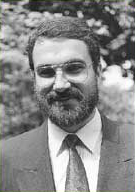Prof. Dr. Franz Michael Dolg
-

- persönliche Homepage
-
Institut für Theoretische Chemie
Greinstraße 4
50939 Köln - (+49) 221 - 470 - 6893
- (+49) 221 - 470 - 6896
- m.dolg@uni-koeln.de
| born: | 1958 |
| diploma thesis: | 1984 (University of Stuttgart) |
| dissertation: | 1989 (University of Stuttgart) |
| postdoc: |
1990 - 1993 (University of Stuttgart) 1991, 1993 (OSU Columbus, Ohio) 1994 - 1999 (MPI-PKS Dresden) |
| habilitation: | 1997 (University of Stuttgart) |
| professorship: | 1999 - 2002 (University of Bonn) |
| in Cologne since: | 2002 |
Theoretical Chemistry
Relativistic quantum chemistry, development of relativistic energy-consistent ab initio pseudopotentials, electronic structure of compounds with heavy and superheavy elements, relativistic effects and electron correlation effects, chemistry of lanthanides and actinides, electronic structure and size-dependent properties of metal clusters, development of quantum chemical ab initio methods for periodic systems, molecular dynamics for amorphous systems
A central research topic of the group is relativistic quantum chemistry, i.e., the application of quantum chemical methods for electronic structure calculations to systems with heavy and superheavy atoms. Relativistic effects in atoms (and as a conse-quence also in molecules) increase roughly with the fourth power of the nuclear charge. For the first-row transition metals relativistic effects cannot be neglected in quantitative investigations, for heavy and superheavy elements they may even change the qualitative behavior. For example, the nonrelativistic ground state configurations 5f27s2 of 90Th and 6d107s1 of 111Eka-Au are changed due to the relativistic destabilisation of the f- respectively d-shell to 6d27s2 and 6d97s2. The computational effort of quantum chemical calculations also increases drastically with the number of electrons. A central topic is there-fore the development of relativistic energy-consistent ab initio pseudopotentials (effective core potentials) for all elements of the periodic table (with exception of H and He). The pseudopotential approach allows to incorporate implicitly the major relativistic contributions for the valence electron system with only little loss of accuracy and without explicitly taking the core electrons into account. The valence electron system is treated essentially within a quasi-nonrelativistic formalism. The pseudopotentials and corresponding optimized valence basis sets developed by the group in cooperation with H. Stoll (University of Stuttgart) are available in the libraries of many quantum chemical standard program packages (e.g. GAUSSIAN, MOLCAS, MOLPRO, TURBOMOLE) as well as some solid state computer codes (e.g. CRYSTAL). New methods of ad-justment, which came available a few years ago, are currently used to further improve the accuracy of the approach. Systems with open d- or even f-shells still pose a considerable challenge to quantum chemical ab initio methods. During the last 15 years we investigated in detail the electronic structure of several lanthanide and actinide compounds. In addition to relativistic effects also electron correlation contributions play a crucial role and often make quantitative investigations quite demanding. Besides the study and prediction of properties of numerous diatomic molecules (e.g. 18 unpaired electrons in the 19Sg- ground state of Gd2, experimentally confirmed) we also investigated several organometallic compounds and sometimes found surprising results (e.g. a 4f1p3 (ca. 80%) + 4f0p4 (ca. 20%) 1A1g ground state of cerocene; experimentally confirmed). A new field of research is the development of quantum chemical ab initio methods for periodic systems, i.e., correlated elect-ronic structure calculations for crystalline solids and polymers. Here the accurate treatment of electron correlation effects is the main challenge. Similar to the modern methods for large molecules, this can be achieved in the basis of localized orbitals. However, in contrast to finite large molecules, the correlation contributions to an infinite solid cannot be determined simply within a single calculation, but rather have to be extracted from a series of calculations for appropriate subsystems summed up to the correlation energy per unit cell using an incremental exansion. Using this approach we could perform in collaborati-on with H. Stoll (University of Stuttgart) the first full configuration interaction calculations for a simple crystalline solid (LiH).
Selected publications:
-
»Electronic Structure Calculations for Molecules Containing Lanthanide Atoms« M. Dolg and H. Stoll in: Handbook of Chemistry and Physics of Rare Earths, Vol. 22, Ch. 152, Ed. L. Eyring, Elsevier, Amsterdam, 1996, 607 - 729.
-
»Lanthanides and Actinides« M. Dolg in: Encyclopedia of Computational Chemistry, Eds. P.v.R. Schleyer, N. L. Allinger, T. Clark, J. Gasteiger, P. A. Kollman, H. F. Schaefer III, P. R. Schreiner, Wiley, Chichester, 1998, 1478 - 1486.
-
»Effective Core Potentials« M. Dolg in: Modern Methods and Algorithms of Quantum Chemistry, NIC Series 1, Ed. J. Grotendorst, John Neumann Institute for Computing, 2000, 479 - 508; Neuauflage NIC Series 3, 2000, 507 - 540.
-
»Relativistic Energy-consistent Pseudopotentials --- Recent Developments« H. Stoll, B. Metz, and M. Dolg, J. Comput. Chem. 2002, 23, 767 - 778.
-
»Quantum Monte Carlo Study of Mercury Clusters« H.-J. Flad, F. Schautz, and M. Dolg in: Recent Advances in Quantum Monte Carlo Methods, Part II, Eds. J. B. Lester Jr., S. M. Rothstein, S. Tanaka, World Scientific, New Jersey, 2002, 183 - 202.
Fellowships/Awards/Other Activities:
- award of the friends of the University of Stuttgart, 1987
- guest professorship at The Ohio State University, Columbus, Ohio, USA, 1991 and 1993
- DFG habilitation fellowship, 1992 - 1994
- Heinz-Maier-Leibnitz award, 1994
- coordinator of the DFG priority programme 1145, 2002 - ...